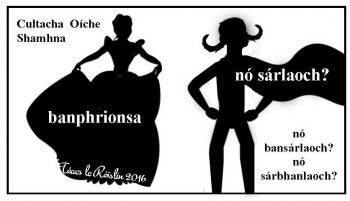Cultacha Banphrionsa vs. Cultacha Sárlaoich: Costume Wars — Princesses vs. Superheroes Posted by róislín on Oct 11, 2016 in Irish Language
(le Róislín)

Cultacha Oíche Shamhna — Cé acu is mó sárdhíola i mbliana, banphrionsa nó sárlaoch? Agus céard faoi bhansárlaoch? Nó sárbhanlaoch? (grafaicí: http://www.clker.com/clipart-princess-silhouette.html agus http://www.clker.com/clipart-super-hero-gray.html, le mionathraithe le Roislin)
Every year around this time I like to check out the articles on the best-selling Halloween costumes (cultacha Oíche Shamhna sárdhíola). Then it’s both fun and, hopefully, informative, to translate them into Irish. Some of them, like “garda” or “comhraiceoir dóiteáin” may also prove to be useful words (focail úsáideacha) for everyday conversation (gnáthchomhrá) as well. Others, like “zombaí” or “vaimpír” are mostly related to this time of year, except of course for the year-round interest in stories like Dracula or programs like “The Walking Dead.”
One thing I learned from reading the latest article on costumes by the National Retail Federation (NRF; nasc thíos) is that princess costumes (cultacha banphrionsa) have dropped to second place for children. “Sárlaochra” now surpass “banphrionsaí.” I’m sort of curious as to how the boy-girl ratio fits into that, but I guess the statistics aren’t really necessary for our language-oriented discussion. Anyway, regarding this change, I’d say, “Hurá!”
The basics for those words are:
an banphrionsa; ainm an bhanphrionsa (the name of the princess, and yes, it’s a masculine noun, grammatically); na banphrionsaí (the princesses); leamh-mheangadh agus fuarchaoineadh na mbanphrionsaí (the simpering and whimpering of the princesses)
an sárlaoch; ainm an tsárlaoich (the name of the superhero), na sárlaochra (the superheroes, an unusual plural even though the noun still belongs to the first-declension category); sárchumhachtaí na sárlaochra (the superpowers of the superheroes)
In theory, at least, we should have words like “*bansárlaoch” (female superhero) and “*sárbhanlaoch” (superheroine). but I don’t see any traces of these online.
I’m especially glad to see that more and more girls can envision themselves as superheroes and that more and more female superheroes actually populate the superhero universe.
The third highest category for children is animals and the article cites the following as examples. I’d say they’re a shoo-in for matchability. Only one of them does not resemble the English:
Béarla: cat, lion, dog, monkey
Gaeilge: moncaí, leon, cat, madra
The NRF article divides adults into two categories, 18 to 34 and 35 and over, with the following as top choice:
Do dhaoine atá idir 18 agus 34: carachtair Batman (Batman é féin, Harley Quinn, agus an Joker, ina measc)
Regarding Harley Quinn, I’d love to call her Hearghaile Ní Chuinn, but I can’t say there’s any precedent for doing so. But “Ó hEarghaile” is “Harley” and “Ó Cuinn,” with the feminine form “Ní Chuinn,” is “Quinn.” Remember, the letter “q” is almost entirely absent from the Irish alphabet, so the “Q-surnames” typically begin with “C” in Irish (Ó Coigligh, for Quigley, etc.). Of course, Harley Quinn’s “real” surname is “Quinzel,” and I guess there’s no traditional Irish equivalent for that.
As for “The Joker,” it would be easy enough to translate his name into Irish, “an cleasaí,” which has a number of additional meanings, including “trickster” (also defined as “caimiléir,” but this sometimes means a conman-type trickster), “acrobat” (more specifically “gleacaí” or “cleasghleacaí”), and “juggler” (also called a “láimhchleasaí). However, I don’t know of any particular precedent for translating the name “The Joker” into Irish either, although “joker” being an generic noun, it seems more plausible. He is, incidentally, supposed to be Irish, according to one passing reference in the Animated Series.
Come to think of it, Harley’s first name is actually “Harleen.” Hmm, “-een” … diminutive ending often seen in Irish English (colleen, houseen, supeen), based on the Irish “-ín” (cailín, teachín/tigín, súimín). Is she supposed to be Irish too?
Do dhaoine os cionn 35:
sa chéad áit: cailleach feasa or just cailleach, in the sense of “witch. I’ve never been completely happy with equating either of these terms with “witch,” which usually has evil implications in English. A “cailleach feasa” is basically a “wise woman,” (wise in the knowledge of herbs, charms, etc., like a “bean feasa“). “Cailleach” on its own has various other meanings, starting, historically, with “nun” (now usually “bean rialta“) and including “hag,” “midwife,” and “precocious girl.” However, it’s hard to fight city hall, and “cailleach” and “cailleach feasa” are commonly equated with “witch.”
sa dara háit: pioráid or, but a bit less typically, these days, I believe, foghlaí mara (lit. sea-raider). I suppose we could debate the definition of a pirate also. If your ship is boarded and your treasure stolen, you may not care if the dastardly deed was committed by a pirate (pioráid or foghlaí mara) or a privateer (mairnéalach príobháideora). And to make things even more interesting, a “foghlaí mara” can also be a “buccaneer.” But that’s either a topic for another type of blog altogether (blag faoi phioráideacht) or, minimally, blagmhír eile sa tsraith seo.
The NRF article also covers cultacha for peataí, but we’re out of space and that’ll have to wait for an chéad bhlagmhír eile. SGF — Róislín
nasc: https://nrf.com/media/press-releases/trading-crowns-capes-superhero-is-top-choice-halloween

Build vocabulary, practice pronunciation, and more with Transparent Language Online. Available anytime, anywhere, on any device.




Leave a comment: